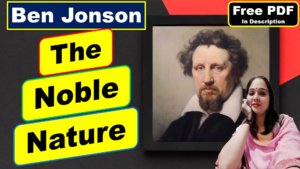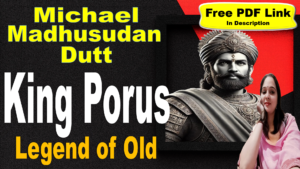Essay Type Questions
Write the critical appreciation of the poem “India Poem” by Shoshee Chunder Dutt.
Introduction: Shoshee Chunder Dutt’s “India” is a powerful sonnet that encapsulates the poet’s dreams and aspirations for his motherland. The poem is a fervent expression of the poet’s longing for freedom and progress in India, reflecting the socio-political context of his time. The poet’s deep love for his country and his desire to see it prosper are evident in his words. His vision of a free and prosperous India serves as a beacon of hope and inspiration, not just for himself, but for all those who share his dream.
Central Idea: The central idea of the poem is the poet’s dream of a free and prosperous India. The poet contemplates the future, shares his dream, and expresses his longing for this dream to become reality. This dream is not just political, but also social and intellectual, encompassing freedom, progress, and the end of suffering.
Structure & Rhyme Scheme: The poem adheres to the structure of an English or Shakespearean sonnet, typically consisting of three quatrains (four-line stanzas) and a final couplet (two-line stanza). The rhyme scheme of ABAB CDCD EFEF GG gives the poem a rhythmic flow and enhances its lyrical quality. The rhyme scheme adds a musical quality to the poem, making it more engaging and memorable.
Theme: The poem “India” by Shoshee Chunder Dutt explores several profound themes:
Longing for Freedom: The most prominent theme in the poem is the longing for freedom. The poet dreams of a future where India is free from oppression and suffering. This longing for freedom is not just political, but also social and intellectual. The poet envisions a nation where liberty is revered, and where people are free to pursue knowledge and progress.
Hope and Anticipation: The poem is imbued with a sense of hope and anticipation. Despite acknowledging that the future is unknown, the poet dares to dream of a brighter future for his country. The “morning light” that the poet refers to symbolizes a new dawn of freedom and hope.
Patriotism: The poem also reflects the poet’s deep love for his country. He refers to India as the “land of my fathers”, indicating his strong emotional connection to his homeland. His dream for a free and prosperous India is a testament to his patriotic spirit.
The Power of Dreams: The poem underscores the power of dreams. The poet asserts that it is no sin to dream, suggesting that dreams can inspire us and guide us towards a better future. His dream of a free and prosperous India serves as a powerful call to action.
Progress and Development: The poem expresses a desire for progress and development. The poet dreams of a future where science soars high again, symbolizing intellectual and technological growth. This reflects the poet’s belief in the power of knowledge and innovation to transform society.
The Struggle against Oppression: The poem depicts the struggle against oppression. The “tear-drops” that the poet sees drying on beauty’s cheek symbolize the end of suffering and oppression. This suggests a future where justice and equality prevail.
Style: The poem is characterized by its lyrical style and use of poetic devices such as metaphor, personification, and symbolism. The poet uses vivid imagery and emotive language to convey his dream of a free and prosperous India. His words paint a vivid picture of his vision, making the poem a powerful and moving tribute to his motherland.
Poetic Devices: The poem employs a variety of poetic devices to convey its themes and messages.
Metaphor: Metaphor is a figure of speech that makes a comparison between two things that are basically dissimilar. In the poem, the future is referred to as a “sealed book”, symbolizing its mystery and unpredictability. The “Freedom’s pure shrine” symbolizes a nation where liberty is revered, and the “morning light” represents a new dawn of freedom and hope.
Personification: Personification is a figure of speech in which an inanimate object or abstraction is given human qualities or abilities. In the poem, the future is personified as a book that is sealed to man. Science is also personified as aspiring to the sky, symbolizing progress and development.
Symbolism: Symbolism is the use of symbols to signify ideas and qualities, by giving them symbolic meanings that are different from their literal sense. In the poem, “tear-drops” symbolize the end of suffering and oppression, and the “smiling strand” represents a peaceful and prosperous land.
Repetition: Repetition is a literary device that repeats the same words or phrases a few times to make an idea clearer and more memorable. In the poem, the phrase “A dream! a dream!” is repeated for emphasis, highlighting the poet’s longing for his dream to become reality.
Rhetorical Question: A rhetorical question is a question asked in order to create a dramatic effect or to make a point rather than to get an answer. In the poem, the poet uses rhetorical questions like “God’s mystic secrets who shall dare to scan?” and “Why should a dream it be?” to provoke thought and emphasize his points.
Apostrophe: Apostrophe is a figure of speech in which the poet addresses an absent person, an abstract idea, or a thing. In the poem, the poet addresses his country directly as “Land of my fathers!” This direct address to an inanimate entity or abstract idea serves to personalize and dramatize the poet’s emotional appeal.
Imagery: Imagery is the use of vivid and descriptive language to add depth to their work. It appeals to human senses to deepen the reader’s understanding of the work. In the poem, the poet uses vivid imagery like “clouds had pass’d beneath the morning light” to paint a picture of a new dawn of freedom and hope.
Message: The message of the poem is a call for liberation, progress, and the end of suffering. The poet urges the reader to strive for freedom and progress, not just for oneself, but for the entire nation. It’s a powerful expression of the poet’s vision for his country, filled with hope, dreams, and a longing for freedom. The poem serves as a reminder of the power of dreams and the importance of hope in shaping the future.
Conclusion: In conclusion, the poem “India” by Shoshee Chunder Dutt is a powerful and moving tribute to his motherland. Through his vivid imagery and emotive language, the poet conveys his deep love for his country and his fervent wish for its freedom and prosperity. The poem serves as a testament to the power of dreams and the importance of hope in shaping the future. It’s a call to action, urging the reader to strive for freedom and progress, not just for oneself, but for the entire nation.










